M. S. Ansari1, Iqbal A. Khan2, Parveen Beg1, Ahmed M. Nahhas2
1Department of Electronics Engineering, Aligarh Muslim University, Aligarh, 202002, India
2Department of Electrical Engineering, Umm Al Qura University, Makkah, Saudi Arabia
Correspondence to: Iqbal A. Khan, Department of Electrical Engineering, Umm Al Qura University, Makkah, Saudi Arabia.
| Email: |  |
Copyright © 2012 Scientific & Academic Publishing. All Rights Reserved.
Abstract
The design of sinusoidal oscillators has been an active area of research in the field of analog electronics. Particularly, oscillators capable of providing waveforms in phase quadrature and circuits capable of generating multiple phase oscillating voltage and/or current waveforms are of interest from the viewpoint of their applications in communication systems. In this paper, a mixed-mode three phase sinusoidal oscillator, employing Second Generation Dual-X Current Conveyor as the active building block and grounded passive elements, is presented. A feedback scheme consisting of three cascaded inverting first-order low-pass sections is employed to obtain a three phase voltage-mode as well as current-mode sinusoidal signals simultaneously. The condition of oscillations and the frequency oscillations are independently controllable. The proposed circuits are compatible with CMOS integration by virtue of the fact that only MOSFETs and grounded capacitors are utilized. Circuit simulations using PSPICE yielded promising results in the form of excellent matching between the theoretical and simulated values. Variation of the frequency of oscillation with the capacitor value is explored. Electronic control of the frequency of oscillation by means of a control voltage is also demonstrated.
Keywords:
Current conveyor, DXCCII, Sinusoidal Oscillator
Cite this paper: M. S. Ansari, Iqbal A. Khan, Parveen Beg, Ahmed M. Nahhas, Three Phase Mixed-mode CMOS VCO with Grounded Passive Components, Electrical and Electronic Engineering, Vol. 3 No. 6, 2013, pp. 149-155. doi: 10.5923/j.eee.20130306.02.
1. Introduction
Mulitphase oscillators, capable of producing multiple signals that are equally separated in phase, constitute an important functional block in many communication, power electronics and measurement & instrumentation systems [1]–[17]. Typical examples of commonly used multiphase oscillator circuits include decoupled dynamic control of a six phase two-motor drive system, vector control of 1ø–to–3ø pulse-width modulation converter, and control schemes for 5–ø induction motor drives[16]. The technical literature is replete with numerous realizations of such oscillators. Whereas some earlier systems employed complex circuitry, contemporary multiphase oscillating systems have relatively simpler structures[15],[16]. The latter systems have generally utilized first-order low-pass sections to produce the necessary phase shifts of up to 90o with a gain that rolls off beyond the corner frequency. Among the different versions of current conveyors, the second-generation current conveyor (CCII) has proved to be a functionally flexible and versatile building block for the realization of analog functions. Major attractions include higher signal bandwidth, independence of closed-loop gain, high slew rate, greater linearity and wide dynamic range.As a result many filters and oscillators using CCII and exhibiting resistor-less realizations are reported in technical literature. Various designs have been proposed by Abuelma’atti & Al-Qahtani[1], Xi et al.[17], Loescharataramdee[11], Hou & Shen[7], Gift[5], Khan & Beg[9], and Khan & Ansari[8], in the field of multiphase oscillator design. These circuits offer varied desirable functionalities like current-mode outputs, quadrature outputs, multiphase outputs, etc. Other features of interest for such circuits are orthogonal control of the condition of oscillation and frequency of oscillation, low component count and the use of grounded passive components from the viewpoint of monolithic integration. Moreover, it has recently been shown that incorporating a second X-terminal in a CCII (Dual-X CCII or the DXCCII) extends the functionality of the device and therefore opens up avenues for simpler circuits[3],[18],[19]. In this paper, the recently reported building block viz. the Dual-X Current Conveyor (DXCCII) is utilized to realize a CMOS compatible mixed-mode three phase sinusoidal oscillator, using three DXCCIIs and grounded passive elements. The proposed circuit enjoys independent control of frequency of oscillation. PSPICE simulation results are given to validate the theory. Further, electronic tuning of the frequency of oscillation is also demonstrated by replacing the grounded resistors with a MOSFET-based realization of a voltage-controlled resistance. Variation in the frequency of oscillation with capacitor values is also explored and the range of available frequencies is estimated.This paper is organised as follows. Section–II contains the details of the proposed three phase sinusoidal oscillator along with the design equations. Section–III deals with the verification of the operation of the proposed circuit. Voltage control of the frequency of oscillation is also discussed. Section–IV contains concluding remarks.
2. Proposed Circuit
The Dual-X Current Conveyor (DXCCII), which essentially is a combination of the Second Generation Current Conveyor (CCII) and the Inverting Second Generation Current Conveyor (ICCII), is a versatile building block for analog signal processing applications. Much of the versatility of DXCCII-based circuits is attributed to the presence of both the ‘normal’ and the ‘inverting’ X-terminals thereby resulting in two unique outputs at the Z+ and Z– terminals. Fig. 1 shows the symbolic diagram of a typical DXCCII whose port relations are given in (1). While the XP terminal voltage follows the voltage at the Y terminal and the XN terminal voltage is the ‘inverted’ version of the voltage at the Y terminal, the currents injected at the XP and XN terminals are replicated to the ZP and ZN terminals respectively.  | Figure 1. Electrical symbol of DXCCII |
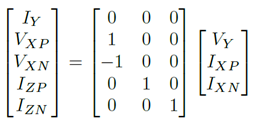 | (1) |
An ideal DXCCII would exhibit zero input resistance at XP and XN terminals and infinite resistance at all the remaining terminals. Next, the design of the proposed mixed-mode three phase sinusoidal oscillator (MTSO) is presented. The basic building block for the MTSO is the DXCCII-based first-order inverting low-pass filter. Each of these sections is realized using a single DXCCII, grounded resistors and capacitors. Three such inverting low-pass filters can be connected in a feedback loop to yield a three phase oscillator as shown in Fig. 2. The characteristic equation for the third-order oscillator is given by  | (2) |
from which the frequency of oscillation (FO) and condition of oscillation (CO) may be obtained as | (3) |
 | (4) |
As can be seen from (3) and (4), orthogonal control of the frequency and condition of oscillation can be achieved by first setting R2 to obtain the required frequency for a given capacitor value, and then tweaking R1 to set the condition of oscillation. | Figure 2. Proposed DXCCII-based mixed-mode three phase sinusoidal oscillator |
3. Simulation Results
The proposed mixed-mode sinusoidal oscillator was verified with computer simulations done using the PSPICE simulation program. An existing CMOS implementation of the DXCCII was used for simulation purposes, and is reproduced in Fig. 3 for ready reference[18]. Simulations were carried out using 0.25 µm TSMC device model parameters with the power supplies kept as VDD = –VSS = 1.25 V and VB = – 0.3 V. The values of the passive elements were kept as C = 1 pF and R = R1 = 2 KΩ and R2 = 4 KΩ. The frequency of oscillation as measured in PSPICE simulations is found to be 71.001 MHz (which is very close to the designed value of 68.916 MHz) and the obtained three phase voltage and current waveforms are shown in Fig. 4 and Fig. 5 respectively. The frequency spectra for both the voltage-mode and current-mode outputs were also plotted to ascertain the quality of the generated sinusoidal waveform and are shown in Fig. 6 and Fig. 7.  | Figure 3. CMOS realization of DXCCII |
 | Figure 4. Voltage-mode three phase waveforms as obtained after PSPICE simulation of the proposed circuit |
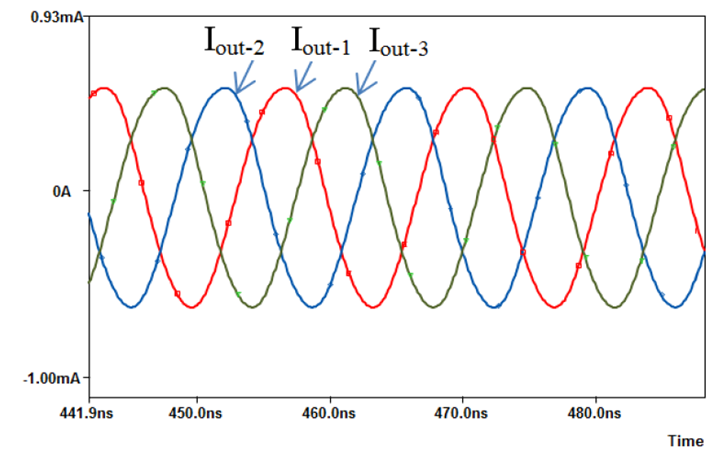 | Figure 5. Current-mode three phase waveforms as obtained after PSPICE simulation of the proposed circuit |
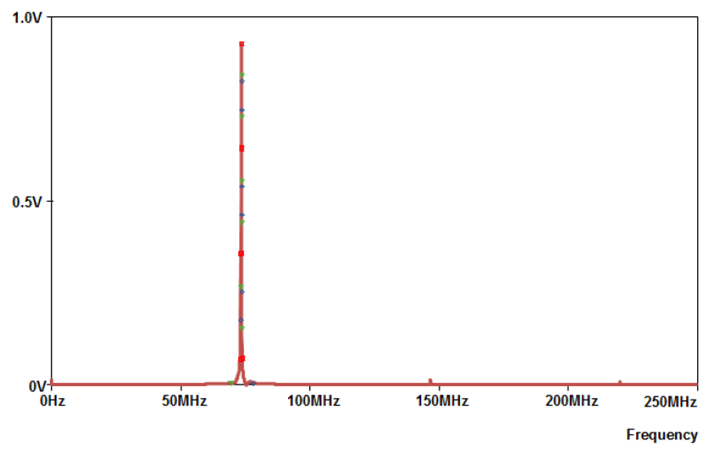 | Figure 6. Frequency spectrum of the voltage-mode three phase waveforms as obtained after PSPICE simulation of the proposed circuit |
The variation in frequency with the value of capacitance was also explored. Fig. 8 shows the results from where it may be observed that there is a non-linear relationship between the frequency of oscillation and the capacitance value, as also evident by (3). Electronic tunability of the proposed circuit was explored by the replacement of the grounded resistor R1 in Fig. 2 by a two-MOSFET implementation of voltage-controlled grounded resistor[3]. As can be seen from Fig. 9, two transistors can be connected in a manner such that the control voltage (VA) governs the resistance offered at the output terminal shown. The resistance RIN, as shown in Fig. 9 is given by | (5) |
where µn is the electron mobility in the MOSFET, Cox is the gate capacitance per unit area, W and L are the width and length of the transistor respectively, VT is the threshold voltage of the NMOS transistors and VA is the control voltage. Time domain voltage-mode sinusoidal waveform obtained at Vout1, with the passive resistor replaced by the MOSFET-based resistance emulation circuit and varying the control voltage VA from 1 V to 1.4 V in steps of 0.1 V, are presented in Fig. 10. Frequency spectra was also plotted for the obtained waveforms and is shown in Fig. 11 from which the variation in frequency with the control voltage can be observed more evidently. | Figure 7. Frequency spectrum of the voltage-mode three phase waveforms as obtained after PSPICE simulation of the proposed circuit |
 | Figure 8. Variation in frequency of oscillation with control voltage |
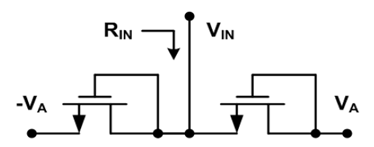 | Figure 9. Voltage controlled MOSFET-based grounded resistor |
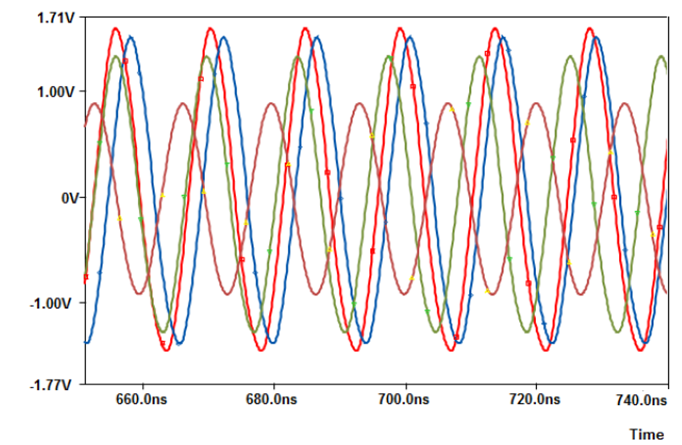 | Figure 10. Simulation results showing Vout1 when the control voltage is varied |
4. Conclusions
This paper serves to contribute to the existing knowledge base of multiphase oscillator circuits based on standard CMOS technology. A recently introduced analog building block viz. the DXCCII has been used in the proposed circuit. A mixed-mode three phase sinusoidal oscillator employing DXCCIIs as the active elements and all grounded passive components is presented. The circuit is CMOS compatible and suitable for monolithic implementation by virtue of the use of all grounded passive elements. Other attractive features of interest are low sensitivities of the frequency of oscillation with respect to the passive elements and independent control of the frequency of oscillations and condition of oscillations. The circuit was simulated using PSPICE and the generated three phase voltage and current waveforms exhibited low harmonic distortion. Electronic tuning of the frequency of oscillation by means of a control voltage is also demonstrated.
References
| [1] | M.T. Abuelmaatti and M.A. Al-Qahtani. A new current-controlled multiphase sinusoidal oscillator using translinear current conveyors. IEEE Transactions on Circuits and Systems II: Analog and Digital Signal Processing, 45(7):881 –885, Jul 1998. |
| [2] | M.S. Ansari. Multiphase sinusoidal oscillator with digital control. In International Conference on Power, Control and Embedded Systems (ICPCES), pages 1–5, Dec. 2010. |
| [3] | Mohd. Samar Ansari and Sumit Sharma. DXCCII-based mixed-mode electronically tunable quadrature oscillator with grounded capacitors. In Srija Unnikrishnan, Sunil Surve, and Deepak Bhoir, editors, Advances in Computing,Communication and Control, volume 125 of Communications in Computer and Information Science, pages 515–521. Springer Berlin Heidelberg, 2011. |
| [4] | Parveen Beg, M. A. Siddiqi, and Mohd. Samar Ansari. Multi output filter and four phase sinusoidal oscillator using CMOS DX-MOCCII. International Journal of Electronics,98(9):1185–1198, 2011. |
| [5] | S.J.G. Gift. Multiphase sinusoidal oscillator using inverting-mode operational amplifiers. IEEE Transactions on Instrumentation and Measurement, 47(4):986–991, Aug 1998. |
| [6] | Jiun-Wei Horng, Chun-Li Hou, Chun-Ming Chang,Shih-Ting Cheng, and Hsin-Yu Su. Current or/and voltage-mode quadrature oscillators with grounded capacitors and resistors using FDCCIIs. WSEAS Trans. Cir. and Sys, 7:129–138, March 2008. |
| [7] | C.-L. Hou and B. Shen. Second-generation current conveyor- based multiphase sinusoidal oscillators. International Journal of Electronics, 78(2):317–325, 1995. |
| [8] | I. A. Khan and M. S. Ansari. Multiphase VCO using CCCIIs. Int. Conf. on Robotics, Vision, Information and Signal Processing (ROVISP07), pages 331–334, Penang, Maleysia, 2007. |
| [9] | I. A. Khan and P. Beg. Fully differential sinusoidal quadrature oscillator using CMOS DVCC. International Conference on Communication, Computer and Power (ICCCP’09), pages 196–198, Muscat, Oman, 2009. |
| [10] | Montree Kumngern, Jirasak Chanwutitum, and Kobchai Dejhan. Electronically tunable multiphase sinusoidal oscillator using translinear current conveyors. Analog Integrated Circuits and Signal Processing, 65:327–334, 2010. |
| [11] | C. Loescharataramdee, W. Kiranon, W. Sangpisit, and W. Yadum. Multiphase sinusoidal oscillators using translinear current conveyors and only grounded passive components. In Proceedings of the 33rd Southeastern Symposium on System Theory, pages 59 –63, Mar 2001. |
| [12] | S. Maheshwari and I.A. Khan. Current controlled third order quadrature oscillator. Circuits, Devices and Systems, IEE Proceedings, pages 605 – 607, Dec. 2005. |
| [13] | S. Maheshwari. Current-mode third-order quadrature oscillator. Circuits, Devices Systems, IET, 4(3):188 –195, May 2010. |
| [14] | G.D. Skotis and C. Psychalinos. Multiphase sinusoidal oscillators using second generation current conveyors. AEU - International Journal of Electronics and Communications, 64(12):1178 – 1181, 2010. |
| [15] | George Souliotis and Costas Psychalinos. Electronically controlled multiphase sinusoidal oscillators using current amplifiers. International Journal of Circuit Theory and Applications, 37(1):43–52, 2009. |
| [16] | Worapong Tangsrirat and Wason Tanjaroen. Current-mode multiphase sinusoidal oscillator using current differencing transconductance amplifiers. Circuits, Systems, and Signal Processing, 27:81–93, 2008. |
| [17] | Yan Hui Xi, Qiao Liu, and Hong Li. Design of multiphase sinusoidal oscillator based on CCCII. In The Sixth World Congress on Intelligent Control and Automation, (WCICA), volume 1, pages 4960 – 4962, 2006. |
| [18] | Shahram Minaei and Erkan Yuce. A new full-wave rectifier circuit employing single dual-X current conveyor. International Journal of Electronics, 95(8):777–784, 2008. |
| [19] | Ali Zeki and Ali Toker. DXCCII-based tunable gyrator. AEU – International Journal of Electronics and Communications, 59(1):59 – 62, 2005. |
















 Abstract
Abstract Reference
Reference Full-Text PDF
Full-Text PDF Full-text HTML
Full-text HTML